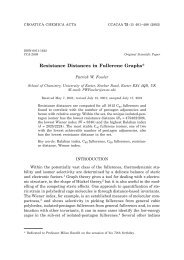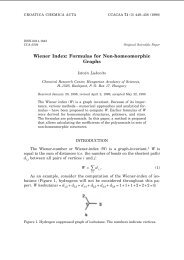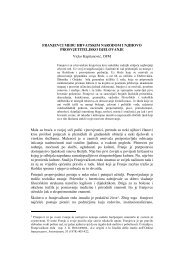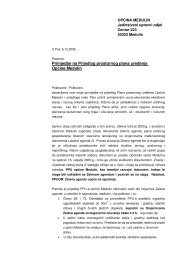Perfect Matchings in Lattice Animals and Lattice Paths with Constraints
Perfect Matchings in Lattice Animals and Lattice Paths with Constraints
Perfect Matchings in Lattice Animals and Lattice Paths with Constraints
- No tags were found...
You also want an ePaper? Increase the reach of your titles
YUMPU automatically turns print PDFs into web optimized ePapers that Google loves.
CROATICA CHEMICA ACTA<br />
CCACAA 78 (2) 251¿259 (2005)<br />
ISSN-0011-1643<br />
CCA-3005<br />
Orig<strong>in</strong>al Scientific Paper<br />
<strong>Perfect</strong> <strong>Match<strong>in</strong>gs</strong> <strong>in</strong> <strong>Lattice</strong> <strong>Animals</strong> <strong>and</strong><br />
<strong>Lattice</strong> <strong>Paths</strong> <strong>with</strong> Constra<strong>in</strong>ts*<br />
Tomislav Do{li}<br />
Department of Informatics <strong>and</strong> Mathematics, Faculty of Agriculture, University of Zagreb,<br />
Sveto{imunska c. 25, 10000 Zagreb, Croatia<br />
(E-mail: doslic@math.hr)<br />
RECEIVED FEBRUARY 22, 2005; REVISED MARCH 2, 2005; ACCEPTED MARCH 8, 2005<br />
Keywords<br />
lattice animal<br />
benzenoid graph<br />
polyom<strong>in</strong>o<br />
lattice path<br />
perfect match<strong>in</strong>g<br />
enumeration<br />
Catalan numbers<br />
Schröder numbers<br />
Delannoy numbers<br />
In the first part of this paper it is shown how to use ear decomposition techniques <strong>in</strong> prov<strong>in</strong>g<br />
existence <strong>and</strong> establish<strong>in</strong>g lower bounds to the number of perfect match<strong>in</strong>gs <strong>in</strong> lattice animals.<br />
A correspondence is then established between perfect match<strong>in</strong>gs <strong>in</strong> certa<strong>in</strong> classes of benzenoid<br />
graphs <strong>and</strong> paths <strong>in</strong> the rectangular lattice that satisfy certa<strong>in</strong> diagonal constra<strong>in</strong>ts. This<br />
correspondence is used to give explicit formulas for the number of perfect match<strong>in</strong>gs <strong>in</strong> hexagonal<br />
benzenoid graphs <strong>and</strong> to derive some identities <strong>in</strong>volv<strong>in</strong>g Fibonacci numbers <strong>and</strong> b<strong>in</strong>omial<br />
coefficients. Some of the results about benzenoid graphs are also translated <strong>in</strong>to the context<br />
of polyom<strong>in</strong>oes.<br />
INTRODUCTION<br />
A lattice animal is a 1-connected collection of congruent<br />
regular polygons arranged <strong>in</strong> a plane <strong>in</strong> such a way that<br />
two polygons are either completely disjo<strong>in</strong>t or have a<br />
common edge. In other words, lattice animals are 1-connected<br />
subsets of regular til<strong>in</strong>gs of the plane consist<strong>in</strong>g<br />
of f<strong>in</strong>ite unions of basic polygonal tiles where any two<br />
tiles are either completely disjo<strong>in</strong>t or share a whole<br />
edge. Obviously, the three different regular til<strong>in</strong>gs of the<br />
plane give rise to three different classes of lattice animals.<br />
In this paper we are concerned <strong>with</strong> two of the<br />
three classes, namely <strong>with</strong> the animals consist<strong>in</strong>g of squares<br />
<strong>and</strong> of regular hexagons. The square animals are also<br />
known as polyom<strong>in</strong>oes, <strong>and</strong> the hexagonal ones, due to<br />
their obvious ressemblance to benzenoid hydrocarbons,<br />
as benzenoid systems.<br />
To each lattice animal we can assign a correspond<strong>in</strong>g<br />
animal graph tak<strong>in</strong>g the vertices of polygons as the<br />
vertices of the graph, <strong>and</strong> the sides of polygons as the<br />
edges of the graph. The result<strong>in</strong>g graph is simple, planar,<br />
<strong>and</strong> <strong>in</strong> the case of square <strong>and</strong> hexagonal animals, also bipartite.<br />
The non-bipartiteness of the graphs correspond<strong>in</strong>g<br />
to triangular animals is the ma<strong>in</strong> reason for leav<strong>in</strong>g<br />
them out of the scope of this paper, s<strong>in</strong>ce the techniques<br />
used here do not work for non-bipartite graphs. The vertices<br />
of an animal graph ly<strong>in</strong>g on the border of the <strong>in</strong>f<strong>in</strong>ite<br />
face are called external; other vertices (if any) are<br />
* Dedicated to Dr. Edward C. Kirby on the occasion of his 70 th birthday.
252 T. DO[LI]<br />
called <strong>in</strong>ternal. Borrow<strong>in</strong>g a term from the chemistry of<br />
aromatic hydrocarbons, we call the animal graphs <strong>with</strong>out<br />
<strong>in</strong>ternal vertices catacondensed. Otherwise, the graph<br />
is pericondensed. In the rest of this paper, when referr<strong>in</strong>g<br />
to lattice animals we will, <strong>in</strong> fact, be referr<strong>in</strong>g to the<br />
correspond<strong>in</strong>g animal graphs.<br />
In the follow<strong>in</strong>g sections our attention will be (not<br />
always fairly) divided between the hexagonal <strong>and</strong> the<br />
square lattice animals. In section <strong>Lattice</strong> <strong>Animals</strong> <strong>and</strong><br />
Ear Decompositions we use certa<strong>in</strong> decomposition techniques<br />
to establish the existence of perfect match<strong>in</strong>gs <strong>in</strong><br />
certa<strong>in</strong> classes of lattice animals <strong>and</strong> to derive simple<br />
lower bounds on their number. Then we proceed, <strong>in</strong> section<br />
Benzenoid Parallelograms, by demonstrat<strong>in</strong>g a correspondence<br />
between perfect match<strong>in</strong>gs <strong>in</strong> some special<br />
classes of hexagonal animals <strong>and</strong> lattice paths <strong>in</strong> rectangular<br />
lattices. The correspondence is then used to obta<strong>in</strong><br />
explicit formulas for the number of perfect match<strong>in</strong>gs <strong>in</strong><br />
some classes of hexagonal animals <strong>in</strong> terms of some well-<br />
-known comb<strong>in</strong>atorial sequences, <strong>and</strong> to establish certa<strong>in</strong><br />
identities <strong>in</strong>volv<strong>in</strong>g Fibonacci numbers. We conclude<br />
<strong>with</strong> a section on polyom<strong>in</strong>oes, us<strong>in</strong>g the correspondence<br />
<strong>with</strong> lattice paths to show how Catalan, Schröder <strong>and</strong><br />
Delannoy numbers appear as the enumerat<strong>in</strong>g sequences<br />
of perfect match<strong>in</strong>gs <strong>in</strong> some special polyom<strong>in</strong>oes.<br />
LATTICE ANIMALS AND EAR DECOMPOSITIONS<br />
A perfect match<strong>in</strong>g <strong>in</strong> a graph G is a collection M of<br />
edges of G such that every vertex of G is <strong>in</strong>cident <strong>with</strong><br />
exactly one edge from M. An edge e of G which appears<br />
<strong>in</strong> some perfect match<strong>in</strong>g of G is called allowed; otherwise,<br />
it is forbidden. A graph G is elementary if its allowed<br />
edges form a connected subgraph of G. For bipartite<br />
graphs, elementarity is equivalent to the fact that all<br />
its edges are allowed. 10<br />
There are many criteria for decid<strong>in</strong>g if a given lattice<br />
animal possesses a perfect match<strong>in</strong>g. We present<br />
here some results that follow from the ear decomposition<br />
techniques. We refer the reader to Ref. 10 for a full<br />
description of these techniques.<br />
Let G be a bipartite graph <strong>and</strong> G' subgraph of G. An<br />
ear of G relative to G' is any odd-length path <strong>in</strong> G hav<strong>in</strong>g<br />
both endpo<strong>in</strong>ts – but no <strong>in</strong>terior po<strong>in</strong>t – <strong>in</strong> G'. A bipartite<br />
ear decomposition of G start<strong>in</strong>g <strong>with</strong> G' is a representation<br />
of G <strong>in</strong> the form G = G'+P 1 +…+P k , where P 1<br />
is an ear of G'+P 1 relative to G', <strong>and</strong> P i is an ear of<br />
G'+P 1 +…+P i relative to G'+P 1 +…+P i–1 for 2 i k.<br />
An ear decomposition of a given graph is not unique.<br />
Proposition 2.1<br />
Every catacondensed lattice animal has a bipartite ear<br />
decomposition start<strong>in</strong>g <strong>with</strong> any edge.<br />
Proof<br />
Every catacondensed benzenoid graph <strong>with</strong> h hexagons<br />
can be constructed start<strong>in</strong>g from an arbitrary edge, add<strong>in</strong>g<br />
an ear of length five to obta<strong>in</strong> the first hexagon <strong>and</strong><br />
then add<strong>in</strong>g one hexagon at every further step. But add<strong>in</strong>g<br />
a hexagon means add<strong>in</strong>g only five new edges to the<br />
graph already constructed. It is obvious that these edges<br />
make an ear <strong>in</strong> the above sense. So, every catacondensed<br />
benzenoid has a bipartite ear decomposition start<strong>in</strong>g from<br />
any of its edges. Similarly, every catacondensed polyom<strong>in</strong>o<br />
can be constructed start<strong>in</strong>g from a s<strong>in</strong>gle edge <strong>and</strong><br />
add<strong>in</strong>g ears consist<strong>in</strong>g of three edges, one at a time.<br />
Hence, the claim is also valid for polyom<strong>in</strong>oes. <br />
We refer the reader to the p. 124 of Ref. 10 for the<br />
proof of the fact that a graph is elementary bipartite if<br />
<strong>and</strong> only if it has a bipartite ear decomposition. S<strong>in</strong>ce<br />
each ear <strong>in</strong> a bipartite ear decomposition contributes at<br />
least one new perfect match<strong>in</strong>g, we get a lower bound<br />
for the number of perfect match<strong>in</strong>gs <strong>in</strong> a catacondensed<br />
lattice animal.<br />
Corollary 2.2<br />
There are at least h + 1 perfect match<strong>in</strong>gs <strong>in</strong> a catacondensed<br />
lattice animal <strong>with</strong> h basic polygons. <br />
The lower bound from the Corollary 2.2 is a sharp<br />
one, <strong>in</strong> the sense that there are catacondensed benzenoids<br />
for which this bound is atta<strong>in</strong>ed. Namely, it is easy to<br />
see that a straight l<strong>in</strong>ear cha<strong>in</strong> of h hexagons conta<strong>in</strong>s<br />
exactly h+1 perfect match<strong>in</strong>gs. In the case of polyom<strong>in</strong>oes,<br />
the lower bound is atta<strong>in</strong>ed for the class of zig-zag<br />
polyom<strong>in</strong>oes, like the one shown <strong>in</strong> Figure 1.<br />
There is a vast literature on the subject of enumeration<br />
of perfect match<strong>in</strong>gs <strong>in</strong> benzenoid graphs. For a review,<br />
the reader should consult Ref. 3. The polyom<strong>in</strong>oes<br />
have so far attracted much less attention.<br />
Figure 1. Extremal lattice animals <strong>with</strong> respect to the number of<br />
perfect match<strong>in</strong>gs.<br />
Elementary benzenoid graphs are also called normal<br />
<strong>in</strong> chemical literature. If we adopt the same term<strong>in</strong>ology<br />
for the polyom<strong>in</strong>oes, it is easy to show that the result<br />
<strong>and</strong> the lower bound of Corollary 2.2 rema<strong>in</strong> valid also<br />
for the case of normal lattice animals. Accord<strong>in</strong>g to Theorem<br />
7.6.2 of Ref. 10, any elementary bipartite graph on<br />
p vertices <strong>and</strong> q edges conta<strong>in</strong>s at least q–p+2 different<br />
perfect match<strong>in</strong>gs. The claim now follows us<strong>in</strong>g Euler<br />
formula q+1 = p+h. Hence, we have the follow<strong>in</strong>g result.<br />
Croat. Chem. Acta 78 (2) 251–259 (2005)
PERFECT MATCHINGS IN LATTICE ANIMALS 253<br />
Corollary 2.3<br />
There are at least h+1 different perfect match<strong>in</strong>gs <strong>in</strong> a<br />
normal lattice animal <strong>with</strong> h polygons.<br />
<br />
This result is a generalization of Theorem 13 of Ref. 3.<br />
Non-elementary benzenoid graphs are, <strong>in</strong> chemical<br />
literature, called essentially disconnected. They conta<strong>in</strong><br />
edges that do not appear <strong>in</strong> any perfect match<strong>in</strong>g. The<br />
l<strong>in</strong>ear lower bound of Corollary 2.3 is not valid for the<br />
case of non-normal benzenoids. In Figure 2 we show an<br />
essentially disconnected benzenoid <strong>with</strong> 11 hexagons <strong>and</strong><br />
only 9 perfect match<strong>in</strong>gs. From this example it is easy to<br />
see that there are essentially disconnected benzenoids<br />
<strong>with</strong> arbitrary many hexagons <strong>and</strong> no more than 9 perfect<br />
match<strong>in</strong>gs.<br />
5-edge ear to the already constructed graph. After complet<strong>in</strong>g<br />
the lower-most row, start add<strong>in</strong>g hexagons <strong>in</strong> the<br />
row immediately above it, aga<strong>in</strong> from the right to the<br />
left. The rightmost one will contribute a 5-edge ear, <strong>and</strong><br />
every other will add a 3-edge ear to the already constructed<br />
graph. Repeat<strong>in</strong>g the same procedure for all the<br />
other rows, we get an ear decomposition of B m,n <strong>with</strong> exactly<br />
mn + 1 ears, count<strong>in</strong>g the first hexagon as two ears.<br />
The claim now follows, s<strong>in</strong>ce every ear <strong>in</strong> the ear decomposition<br />
br<strong>in</strong>gs at least one new perfect match<strong>in</strong>g. 10<br />
<br />
An example of a perfect match<strong>in</strong>g <strong>in</strong> B 3,4 is shown<br />
<strong>in</strong> Figure 4.<br />
We see that this match<strong>in</strong>g conta<strong>in</strong>s exactly one vertical<br />
edge from each row. We can prove that this is always<br />
the case.<br />
Figure 2. An essentially disconnected benzenoid <strong>with</strong> 11 hexagons<br />
<strong>and</strong> only 9 perfect match<strong>in</strong>gs.<br />
BENZENOID PARALLELOGRAMS<br />
Let us now consider one simple class of benzenoid graphs,<br />
benzenoid parallelograms.<br />
A benzenoid parallelogram B m,n consists of m n<br />
hexagons, arranged <strong>in</strong> m rows, each row conta<strong>in</strong><strong>in</strong>g n<br />
Figure 3. A benzenoid parallelogram.<br />
hexagons, shifted for half a hexagon to the right from<br />
the row immediately below.<br />
Benzenoid parallelograms are not catacondensed,<br />
but we can still use the ear decomposition technique to<br />
show that they have perfect match<strong>in</strong>gs.<br />
Proposition 3.1<br />
Every benzenoid parallelogram B m,n is an elementary<br />
graph, <strong>and</strong> it conta<strong>in</strong>s at least mn + 1 perfect match<strong>in</strong>gs.<br />
Proof<br />
We shall display a bipartite ear decomposition of B m,n<br />
<strong>with</strong> exactly mn +1 ears. Start<strong>in</strong>g from the rightmost<br />
hexagon <strong>in</strong> the lower-most row, add the hexagons to the<br />
left of it, one at a time. Each of them will contribute one<br />
Figure 4. A perfect match<strong>in</strong>g <strong>in</strong> B 3,4 .<br />
Lemma 3.2<br />
Every perfect match<strong>in</strong>g <strong>in</strong> a benzenoid parallelogram<br />
B m,n conta<strong>in</strong>s precisely one vertical edge of each row.<br />
Proof<br />
Let us consider a benzenoid parallelogram B m,n <strong>and</strong> a<br />
perfect match<strong>in</strong>g M <strong>in</strong> B m,n . The vertex set of B m,n is partitioned<br />
<strong>in</strong> two sets, W (for white) <strong>and</strong> B (for black) <strong>in</strong><br />
such a way that the top vertices of all hexagons are white.<br />
Suppose that there is a row, say the i-th one, such that no<br />
vertical edge from it is conta<strong>in</strong>ed <strong>in</strong> M. By remov<strong>in</strong>g all<br />
vertical edges of this row, we decompose the parallelogram<br />
B m,n <strong>in</strong>to the components B + <strong>and</strong> B – . An example<br />
of such procedure is shown <strong>in</strong> Figure 5.<br />
Figure 5. With the proof of Lemma 3.2.<br />
B<br />
–<br />
+<br />
B<br />
Each of deleted edges connects a black vertex of B +<br />
<strong>with</strong> a white one of B – . Further, <strong>in</strong> B + the number of<br />
black vertices exceeds the number of white ones by precisely<br />
one (<strong>and</strong> conversely <strong>in</strong> B – ). Hence, any perfect<br />
match<strong>in</strong>g <strong>in</strong> B m,n must conta<strong>in</strong> precisely one vertical edge<br />
from the considered row.<br />
<br />
Croat. Chem. Acta 78 (2) 251–259 (2005)
254 T. DO[LI]<br />
So, every perfect match<strong>in</strong>g M of a benzenoid parallelogram<br />
B m,n conta<strong>in</strong>s exactly one vertical edge from<br />
each row of B m,n . There are n+1 vertical edges <strong>in</strong> every<br />
row of B m,n . Label them consecutively from the left to<br />
the right <strong>with</strong> <strong>in</strong>teger labels 0,1,2, …, n. For a given perfect<br />
match<strong>in</strong>g M, let i p be the label of the vertical edge<br />
from the p-th row conta<strong>in</strong>ed <strong>in</strong> M.<br />
Lemma 3.3<br />
The sequence (i 1 ,…,i m ) is non-decreas<strong>in</strong>g for every<br />
perfect match<strong>in</strong>g M of a benzenoid parallelogram B m,n .<br />
Proof<br />
Consider a perfect match<strong>in</strong>g M <strong>in</strong> B m,n <strong>and</strong> suppose that<br />
there is a p m–1 such that i p > i p+1 . Remove all vertical<br />
edges from the p-th row which are to the left from i p .<br />
(We count the rows from bottom to top.) The rema<strong>in</strong><strong>in</strong>g<br />
graph, B' m,n as shown <strong>in</strong> Figure 6, will have a pendant<br />
vertex. Denote this vertex by a. Consider the shortest<br />
path connect<strong>in</strong>g the vertex a <strong>with</strong> x, the lower endpo<strong>in</strong>t<br />
of the vertical edge i p+1 from M, <strong>and</strong> denote it by P. No<br />
vertex of P–x is covered by a vertical edge of M, <strong>and</strong><br />
yet, as no edges from M were removed, all vertices of<br />
p–x must be covered by some edge of M. But the card<strong>in</strong>ality<br />
of V(P)–x is necessarily odd <strong>and</strong> we have arrived<br />
at a contradiction.<br />
<br />
Proposition 3.5<br />
There is a bijection between the set of all perfect match<strong>in</strong>gs<br />
<strong>in</strong> B m,n <strong>and</strong> the set of all non-decreas<strong>in</strong>g sequences<br />
of length m <strong>with</strong> elements from 0,1,... n.<br />
Proof<br />
It follows from Lemma 3.3 <strong>and</strong> Corollary 3.4 that the<br />
positions of vertical edges <strong>in</strong> a perfect match<strong>in</strong>g uniquely<br />
def<strong>in</strong>e a non-decreas<strong>in</strong>g sequence of length m <strong>with</strong> elements<br />
from 0,1,... n. To prove the other part, take a<br />
nondecreas<strong>in</strong>g sequence (i 1 , i 2 ,..., i m ) <strong>with</strong> elements from<br />
0,1,...,n <strong>and</strong> construct a match<strong>in</strong>g <strong>in</strong> B m,n by tak<strong>in</strong>g the<br />
vertical edge i p <strong>in</strong> the row p. Denote this match<strong>in</strong>g by V<br />
<strong>and</strong> suppose that there are two different perfect match<strong>in</strong>gs,<br />
M' <strong>and</strong> M'', such that V M', V M''. Consider<br />
their symmetric difference M'M''. Any edge from M'M''<br />
must be non vertical. By Corollary 3.4, no edge of M'M''<br />
may lie left <strong>and</strong> above of any edges of V. Similarly, no<br />
such edges can exist right <strong>and</strong> below the edges from V.<br />
The only rema<strong>in</strong><strong>in</strong>g possibility is that they are on paths<br />
connect<strong>in</strong>g the upper end of the vertical edge i p <strong>with</strong> the<br />
lower end of the edge i p+1 . But all such paths must have<br />
an even number of <strong>in</strong>ner vertices, <strong>and</strong> their perfect match<strong>in</strong>gs<br />
are unique. So, we have M'M'' = , <strong>and</strong> hence<br />
M'=M''. Therefore, each choice of m vertical edges <strong>with</strong><br />
nondecreas<strong>in</strong>g labels def<strong>in</strong>es a unique perfect match<strong>in</strong>g<br />
M of B m,n .<br />
<br />
Corollary 3.4<br />
Let M be a perfect match<strong>in</strong>g <strong>in</strong> B m,n conta<strong>in</strong><strong>in</strong>g the vertical<br />
edge i p <strong>in</strong> the row p. Then the part of M ly<strong>in</strong>g <strong>in</strong> the<br />
rows p+1,..., m, left from their respective i p -th vertical<br />
edges is uniquely determ<strong>in</strong>ed. Similarly, the part of M<br />
ly<strong>in</strong>g <strong>in</strong> the rows 1,..., p–1, right to their respective i p -th<br />
rows is uniquely determ<strong>in</strong>ed.<br />
Proof<br />
a<br />
Figure 6. With the proof of Lemma 3.3.<br />
x<br />
Let us first consider the part of B m,n above <strong>and</strong> left from<br />
the i p -th vertical edge of the p-th row. No vertical edge<br />
from this part may be <strong>in</strong> M, <strong>and</strong> the conditions on the<br />
boundary force both non-vertical edges on the left side<br />
of every hexagon <strong>in</strong> this part of B n.m to be <strong>in</strong> M. A similar<br />
argument holds for the part of B m,n below <strong>and</strong> right of<br />
the considered vertical edge.<br />
<br />
CORRESPONDENCE WITH LATTICE PATHS<br />
A lattice path of length n between the po<strong>in</strong>ts P 0 <strong>and</strong> P n <strong>in</strong><br />
the (x,y) coord<strong>in</strong>ate plane is any sequence P of n segments<br />
(Pj1<br />
Pj) j 1<br />
n<br />
both of whose endpo<strong>in</strong>ts have <strong>in</strong>teger<br />
coord<strong>in</strong>ates. The segment Pj1Pj<br />
is called the j-th step of<br />
the path P. By impos<strong>in</strong>g various restrictions on the size<br />
<strong>and</strong> orientation of steps, on the <strong>in</strong>itial <strong>and</strong> f<strong>in</strong>al po<strong>in</strong>ts,<br />
<strong>and</strong> on the areas of the lattice that must be visited or<br />
avoided by the path, we obta<strong>in</strong> different classes of lattice<br />
paths. We consider here lattice paths <strong>in</strong> a rectangular lattice<br />
<strong>with</strong> <strong>in</strong>teger coord<strong>in</strong>ates from (0,0) to (n,m) <strong>with</strong><br />
steps of type (1,0) <strong>and</strong> (0,1). Denote the set of all such<br />
paths <strong>with</strong> P n.m .<br />
Proposition 4.1<br />
There is a one-to-one correspondence between the set of<br />
all lattice paths from (0,0) to (n,m) <strong>with</strong> steps (1,0) <strong>and</strong><br />
(0,1) <strong>and</strong> the set of all nondecreas<strong>in</strong>g sequences of length<br />
m <strong>with</strong> elements from 0,...,n.<br />
Proof<br />
Let us take a lattice path from P n.m .Ithasm+n steps, m<br />
of them vertical (i.e. of type (0,1)). By writ<strong>in</strong>g down<br />
their abscissas, we get a nondecreas<strong>in</strong>g sequence of length<br />
Croat. Chem. Acta 78 (2) 251–259 (2005)
PERFECT MATCHINGS IN LATTICE ANIMALS 255<br />
m <strong>with</strong> elements from 0, ..., n, <strong>and</strong> the correspondence<br />
is obviously <strong>in</strong>jective. On the other h<strong>and</strong>, take a nondecreas<strong>in</strong>g<br />
sequence of length m <strong>with</strong> elements from 0, ...,<br />
n <strong>and</strong> construct a lattice path start<strong>in</strong>g from (0,0) <strong>with</strong><br />
vertical steps connect<strong>in</strong>g the po<strong>in</strong>ts (i j , j–1) <strong>and</strong> (i j , j) for<br />
j = 1, ..., m. By <strong>in</strong>sert<strong>in</strong>g horizontal steps from (i j , j) to<br />
(i j+1 , j), j = 1, ..., m–1 <strong>and</strong> the steps from (0,0) to (i 1 ,0)<br />
<strong>and</strong> (0,1) <strong>and</strong> from (i m , m) to(n, m), if needed, we get a<br />
lattice path from (0,0) to (n, m) <strong>with</strong> steps (1,0) <strong>and</strong> (0,1),<br />
<strong>and</strong> the correspondence is aga<strong>in</strong> <strong>in</strong>jective. <br />
Theorem 4.2<br />
There is a one-to-one correspondence between the set of<br />
all perfect match<strong>in</strong>gs <strong>in</strong> a benzenoid parallelogram B m,n<br />
<strong>and</strong> the set of all lattice paths from (0,0) to (n, m) <strong>with</strong><br />
steps (1,0) <strong>and</strong> (0,1).<br />
Proof<br />
Follows from comb<strong>in</strong><strong>in</strong>g Proposition 3.5. <strong>and</strong> Proposition<br />
4.1.<br />
<br />
An example of this correspondence is illustrated <strong>in</strong><br />
Figure 7.<br />
Figure 7. A perfect match<strong>in</strong>g <strong>in</strong> B n.m <strong>and</strong> the correspond<strong>in</strong>g lattice<br />
path.<br />
CONSEQUENCES AND APPLICATIONS<br />
The most obvious consequence of Theorem 4.2 is an exact<br />
formula for the number of perfect match<strong>in</strong>gs <strong>in</strong> B m,n .<br />
The result was obta<strong>in</strong>ed long time ago by Gordon <strong>and</strong><br />
Davison, us<strong>in</strong>g essentially the same correspondence, but<br />
<strong>in</strong> a less formal manner. 3,7<br />
Proposition 5.1.<br />
<br />
K(B m,n )= m n m n<br />
<br />
n <br />
<br />
m <br />
<br />
<br />
The Theorem 4.2. also enables us to get exact formulas<br />
for number of perfect match<strong>in</strong>gs <strong>in</strong> various benzenoid<br />
graphs which may be obta<strong>in</strong>ed from benzenoid parallelograms<br />
by delet<strong>in</strong>g some subgraphs.<br />
As a first example, consider the benzenoid graph T n<br />
consist<strong>in</strong>g of n rows of hexagons, <strong>with</strong> the number of<br />
hexagons <strong>in</strong> a row decreas<strong>in</strong>g by one from n <strong>in</strong> the lower-most<br />
row to one <strong>in</strong> the uppermost row, each row shifted<br />
for one <strong>and</strong> a half hexagon to the right from the row<br />
immediately below it. An example of such graph is<br />
shown <strong>in</strong> Figure 8.<br />
Figure 8. A triangular benzenoid.<br />
Proposition 5.2<br />
K(T n )=C n+1 ,<br />
where C n+1 is the (n+1)-st Catalan number.<br />
Proof<br />
Us<strong>in</strong>g Theorem 4.2. we can see that every perfect<br />
match<strong>in</strong>g <strong>in</strong> T n corresponds to a lattice path from (0,0)<br />
to (n+1, n+1) <strong>with</strong> the steps (1,0) <strong>and</strong> (0,1) that always<br />
rema<strong>in</strong>s below the l<strong>in</strong>e y=x. Such paths are known as<br />
Dyck paths, <strong>and</strong> it is well known (see e.g. Ref. 15) that<br />
the number of Dyck paths on 2n steps is C n+1 . <br />
The Catalan numbers, 1, 1, 2, 5, 14, 42, 132,... are<br />
one of the most ubiquitous sequences of enumerative<br />
comb<strong>in</strong>atorics. They appeared already <strong>in</strong> the 18 th century,<br />
<strong>in</strong> works of Euler, <strong>and</strong> got their name after a Belgian<br />
mathematician E. C. Catalan, who wrote a paper<br />
about them <strong>in</strong> 1838. 1 S<strong>in</strong>ce then, more than a hundred<br />
different families of objects counted by Catalan numbers<br />
have been found. 15 Certa<strong>in</strong>ly, this is not the first appearance<br />
of Catalan numbers <strong>in</strong> a chemical context. The best<br />
known example of their occurrence is as the number of<br />
ways to couple 2n electrons <strong>in</strong> 2n simply occupied orbitals<br />
to form a s<strong>in</strong>glet wave-function. They also arise <strong>in</strong><br />
the enumeration of Morgan trees 4 <strong>and</strong> <strong>in</strong> polymer statistics.<br />
The result of Proposition 5.2 has been obta<strong>in</strong>ed <strong>in</strong><br />
Ref. 16. Also, the triangular benzenoids T n have not<br />
been overlooked by authors of Ref. 3. They give explicit<br />
formulas for K(T n ), obta<strong>in</strong>ed by deriv<strong>in</strong>g recurrence relations<br />
for broader classes of benzenoids <strong>and</strong> then specializ<strong>in</strong>g<br />
certa<strong>in</strong> parameters. Us<strong>in</strong>g the correspondence<br />
just established, all these results follow at a glance.<br />
Let us now use some known results about enumeration<br />
of lattice paths <strong>with</strong> diagonal constra<strong>in</strong>ts.<br />
Proposition 5.3<br />
Let W(n, m, r, s) denote the number of lattice paths from<br />
(0, 0) to (n, m) not touch<strong>in</strong>g the l<strong>in</strong>es y = x – r <strong>and</strong><br />
y = x + s, for some positive <strong>in</strong>tegers r, s. Then<br />
Croat. Chem. Acta 78 (2) 251–259 (2005)
256 T. DO[LI]<br />
( nm , )<br />
s<br />
(0,0)<br />
r<br />
Figure 9. A part of lattice<br />
between diagonal boundaries<br />
<strong>and</strong> the correspond<strong>in</strong>g<br />
benzenoid graph.<br />
<br />
W(n, m, r, s) = m n <br />
<br />
m <br />
<br />
<br />
i³1<br />
<br />
m<br />
n<br />
m n<br />
<br />
m<br />
it <br />
<br />
<br />
n<br />
it <br />
<br />
<br />
<br />
m<br />
n m n<br />
<br />
i nrit <br />
<br />
<br />
msit<br />
<br />
³0 <br />
<br />
where t = r + s.<br />
<br />
For the proof of this proposition, one can see Ref. 8.<br />
Many other results about lattice paths between diagonal<br />
boundaries can be found <strong>in</strong> Ref. 11.<br />
Prohibit<strong>in</strong>g the lattice paths from touch<strong>in</strong>g the l<strong>in</strong>es<br />
y = x – r <strong>and</strong> y = x + s effectively conf<strong>in</strong>es them to the<br />
hexagonal portion of the lattice, delimited by the said<br />
two l<strong>in</strong>es <strong>and</strong> the l<strong>in</strong>es x =0,x = n, y = 0 <strong>and</strong> y = m. By<br />
replac<strong>in</strong>g each unit square of the lattice which is whole<br />
conta<strong>in</strong>ed <strong>in</strong> this area <strong>with</strong> a regular hexagon, we get a<br />
benzenoid graph whose every perfect match<strong>in</strong>g corresponds<br />
to a lattice path conf<strong>in</strong>ed between the l<strong>in</strong>es y = x – r<br />
<strong>and</strong> y = x + s. Let us denote such a graph, determ<strong>in</strong>ed by<br />
the parameters n, m, r <strong>and</strong> s by B n,m,r,s . An example of<br />
such correspondence is shown <strong>in</strong> Figure 9.<br />
Corollary 5.4<br />
<br />
K(B n,m,r,s )= m n <br />
<br />
m <br />
<br />
where t = r + s.<br />
Proof<br />
<br />
i³1<br />
<br />
m<br />
n<br />
m n<br />
<br />
m<br />
it <br />
<br />
<br />
n<br />
it <br />
<br />
<br />
<br />
m<br />
n m n<br />
<br />
i nrit <br />
<br />
<br />
msit<br />
<br />
³0 <br />
<br />
Follows by comb<strong>in</strong><strong>in</strong>g the Theorem 4.2 <strong>and</strong> Proposition<br />
5.3. <br />
The follow<strong>in</strong>g results are obta<strong>in</strong>ed by specializ<strong>in</strong>g<br />
certa<strong>in</strong> parameters <strong>in</strong> Corollary 5.4.<br />
Corollary 5.5<br />
<br />
K(B n,m,r,s )= m n m n<br />
<br />
m <br />
<br />
n<br />
s <br />
<br />
for m–n s m, r n.<br />
<br />
Corollary 5.6<br />
K(B n,n,2,2 )=2 n ;<br />
K(B n,n,3,3 )=2 3 n ;<br />
K(B n+1,n,3,3 )=3 n ;<br />
K(B k+1,k–1,3,3 )=3 k–1 .<br />
The correspondence can also be used <strong>in</strong> the opposite direction:<br />
By tak<strong>in</strong>g some known explicit formulas for<br />
number of perfect match<strong>in</strong>gs <strong>in</strong> certa<strong>in</strong> benzenoid graphs,<br />
we can derive some curious identities. Here are two examples<br />
<strong>in</strong>volv<strong>in</strong>g Fibonacci numbers.<br />
Corollary 5.7<br />
2k<br />
<br />
F 2k =<br />
<br />
k 1 <br />
<br />
Proof<br />
<br />
i³1<br />
<br />
2k<br />
2k<br />
<br />
k15i <br />
<br />
<br />
k15i<br />
<br />
<br />
<br />
<br />
<br />
2k<br />
2k<br />
<br />
i 0 k25i <br />
<br />
<br />
k35i<br />
<br />
³ <br />
<br />
It is well known 3 that the number of perfect match<strong>in</strong>gs<br />
<strong>in</strong> a zig-zag cha<strong>in</strong> <strong>with</strong> h hexagons is F h+2 . But the zig-<br />
-zag cha<strong>in</strong> <strong>with</strong> k–2 hexagons can be obta<strong>in</strong>ed as B n,m,r,s ,<br />
tak<strong>in</strong>g n = k +1,m = k –1,r =3,s = 2. The claim now follows<br />
from Corollary 5.4.<br />
<br />
By the same reason<strong>in</strong>g, we can prove the follow<strong>in</strong>g<br />
result.<br />
Corollary 5.8<br />
F 2k+1 =<br />
2k<br />
2k<br />
2k<br />
2k<br />
<br />
2<br />
k <br />
<br />
k<br />
5i <br />
<br />
<br />
k25i <br />
<br />
<br />
k 3<br />
<br />
i ³ 1 i³<br />
0 <br />
5i<br />
We conclude our review by present<strong>in</strong>g two explicit formulas<br />
derived from our correspondence, that are not <strong>in</strong><br />
Ref. 3.<br />
<br />
Croat. Chem. Acta 78 (2) 251–259 (2005)
PERFECT MATCHINGS IN LATTICE ANIMALS 257<br />
Corollary 5.9<br />
1<br />
K(B n+1,n,5,5 )=5 n/2 F n+1 ,<br />
2<br />
.<br />
. .<br />
n<br />
for n even.<br />
<br />
Corollary 5.10<br />
K(B n+3,n,5,5 )=5 (n+1)/2 F n+1 ,<br />
for n odd.<br />
<br />
In recent years, perfect match<strong>in</strong>gs <strong>in</strong> benzenoids<br />
have been <strong>in</strong>tensively studied for their connections <strong>with</strong><br />
til<strong>in</strong>gs of »Aztec diamonds« <strong>and</strong> plane partitions, 12 <strong>and</strong><br />
many <strong>in</strong>terest<strong>in</strong>g results for special cases have been obta<strong>in</strong>ed<br />
(see, e.g. Refs. 2 <strong>and</strong> 5). Aztec diamonds also appear<br />
<strong>in</strong> our next section.<br />
Figure 10. An Aztec diamond.<br />
1<br />
2<br />
.<br />
. .<br />
n<br />
PERFECT MATCHINGS IN SOME CLASSES OF<br />
POLYOMINOES<br />
We have already mentioned that the results express<strong>in</strong>g<br />
the number of perfect match<strong>in</strong>gs <strong>in</strong> various special classes<br />
of polyom<strong>in</strong>oes are far less abundant than those for<br />
hexagonal animals. The best known, <strong>and</strong> historically the<br />
most important, is the formula for the number of perfect<br />
match<strong>in</strong>gs <strong>in</strong> a rectangular grid of m n vertices (i.e., <strong>in</strong><br />
a rectangular polyom<strong>in</strong>o of (m–1) (n–1) squares):<br />
K(L m–1,n–1 )=2 mn/2 m n<br />
<br />
<br />
k1l<br />
1<br />
<br />
cos<br />
kp<br />
lp<br />
<br />
cos<br />
m+ 1 n+ 1<br />
<br />
2 2<br />
For more <strong>in</strong>formation about this result we refer the reader<br />
to Ref. 10, p. 329. By sett<strong>in</strong>g one of the parameters,<br />
say n, to 2, we obta<strong>in</strong> the ladder graph <strong>with</strong> m rungs, L m .<br />
It is easy to check that K(L m )=F m+1 , where F m+1 denotes<br />
the (m+1)-st Fibonacci number.<br />
Some other classes of polyom<strong>in</strong>oes, most of them<br />
<strong>with</strong> the square symmetry, were considered by Hosoya<br />
<strong>in</strong> his 1986 paper. 9 Among them were the already mentioned<br />
Aztec diamonds. An Aztec diamond is a polyom<strong>in</strong>o<br />
of the type shown <strong>in</strong> Figure 10. It has 2n–1 rows of<br />
squares, the number of squares <strong>in</strong>creas<strong>in</strong>g by 2 from 1 <strong>in</strong><br />
the uppermost row to 2n–1 squares <strong>in</strong> the middle row,<br />
<strong>and</strong> then decreas<strong>in</strong>g aga<strong>in</strong> to 1 <strong>in</strong> the lowermost row.<br />
Hosoya stated, <strong>with</strong>out proof, that the number of<br />
perfect match<strong>in</strong>gs <strong>in</strong> an Aztec diamond A n is given by<br />
K(A n )=2( n 2 1 ). The first proof appeared <strong>in</strong> 1991, <strong>in</strong> a<br />
much cited paper. 6 By doubl<strong>in</strong>g the middle row <strong>in</strong> an<br />
Aztec diamond one obta<strong>in</strong>s an augmented Aztec diamond;<br />
a graph of this type is shown <strong>in</strong> Figure 11. We denote<br />
such graph by AA n .<br />
It was shown by Sachs <strong>and</strong> Zernitz <strong>in</strong> Ref. 13 that<br />
there is a one-to-one correspondence between the set of<br />
all perfect match<strong>in</strong>gs <strong>in</strong> an augmented Aztec diamond<br />
14 /<br />
Figure 11. An augmented Aztec diamond.<br />
1<br />
1<br />
6 <br />
AA n <strong>and</strong> the set of all lattice paths from (0,0) to (2n,0)<br />
us<strong>in</strong>g only the steps of the types (1,1), (1,–1), <strong>and</strong> (2,0).<br />
Such lattice paths are known <strong>in</strong> comb<strong>in</strong>atorial literature<br />
as Delannoy paths, <strong>and</strong> their enumerat<strong>in</strong>g sequence D n<br />
as the sequence of (central) Delannoy numbers. The sequence<br />
beg<strong>in</strong>s as 1,3,13,63,321,1683.... From its generat<strong>in</strong>g<br />
function D(x)=<br />
2<br />
x x<br />
it can be deduced that D n =<br />
P n (3), where P n (x) denotes the n-th Legendre polynomial,<br />
<strong>and</strong> that the sequence has the asymptotic behavior<br />
of (3 + 2 2) n .<br />
By restrict<strong>in</strong>g the paths of Delannoy type to the upper<br />
half-plane, we get a class of paths known as Schröder<br />
paths. Their enumerat<strong>in</strong>g sequence, (large) Schröder<br />
numbers r n , have a number of other comb<strong>in</strong>atorial <strong>in</strong>terpretations<br />
(see Ref. 15, Ex. 6.39), <strong>and</strong> their history goes<br />
all the way back to 1870. 14 It can be shown, follow<strong>in</strong>g<br />
the approach of Sachs <strong>and</strong> Zernitz, that large Schröder<br />
numbers also enumerate the perfect match<strong>in</strong>gs <strong>in</strong> the<br />
graph obta<strong>in</strong>ed from an augmented Aztec diamond by<br />
tak<strong>in</strong>g only its upper half. We denote such a polyom<strong>in</strong>o<br />
by Z n <strong>and</strong> call it a ziggurath of order n. A perfect match<strong>in</strong>g<br />
<strong>in</strong> a ziggurath Z n <strong>and</strong> the correspond<strong>in</strong>g Schröder<br />
path are shown <strong>in</strong> Figure 12a). The correspondence becomes<br />
more clear if the images are superposed, as <strong>in</strong> Figure<br />
12b).<br />
The superposition makes particularly clear the relationship<br />
between the vertical edges <strong>in</strong> a perfect match<strong>in</strong>g<br />
<strong>and</strong> the non-horizontal steps <strong>in</strong> the correspond<strong>in</strong>g Schröder<br />
path.<br />
Croat. Chem. Acta 78 (2) xx–xx (2005)
258 T. DO[LI]<br />
a)<br />
(0,0)<br />
(6,0)<br />
(0,0) (6,0)<br />
b)<br />
Figure 12. A perfect match<strong>in</strong>g<br />
<strong>in</strong> a ziggurath <strong>and</strong> the correspond<strong>in</strong>g<br />
Schröder path.<br />
Figure 13. All-vertical perfect<br />
match<strong>in</strong>gs <strong>in</strong> Z 3 <strong>and</strong> the correspond<strong>in</strong>g<br />
Dyck paths.<br />
As our last task, we consider the perfect match<strong>in</strong>gs<br />
<strong>in</strong> a ziggurath Z n that have exactly 2n vertical edges. (It is<br />
clear from the above correspondence, <strong>and</strong> it can be also<br />
shown us<strong>in</strong>g parity arguments, that no perfect match<strong>in</strong>g<br />
<strong>in</strong> Z n can conta<strong>in</strong> more than 2n vertical edges.) We call<br />
such perfect match<strong>in</strong>gs all-vertical. Such perfect match<strong>in</strong>gs<br />
correspond to the Schröder paths <strong>with</strong>out horizontal<br />
steps, <strong>and</strong> these, <strong>in</strong> turn, are noth<strong>in</strong>g else but the Dyck<br />
paths on 2n steps, reflected across the l<strong>in</strong>e y = x <strong>and</strong> rotated<br />
45 degrees clockwise. Hence, we have the follow<strong>in</strong>g<br />
result:<br />
From Propositions 6.1 <strong>and</strong> 5.2 it follows that there<br />
must exist a bijection between perfect match<strong>in</strong>gs <strong>in</strong> a triangular<br />
benzenoid T n <strong>and</strong> perfect match<strong>in</strong>gs <strong>in</strong> a ziggurath<br />
Z n+1 . We <strong>in</strong>vite the reader to work it out explicitly. Tak<strong>in</strong>g<br />
this bijection as the start<strong>in</strong>g po<strong>in</strong>t, it is possible to<br />
derive the results about the number of perfect match<strong>in</strong>gs<br />
<strong>in</strong> zigguraths <strong>and</strong> augmented Aztec diamonds <strong>in</strong> an alternative<br />
way.<br />
The author is <strong>in</strong>debted to the anonymous referees<br />
for their careful read<strong>in</strong>g of the manuscript <strong>and</strong> valuable<br />
suggestions.<br />
Proposition 6.1<br />
The number of all-vertical perfect match<strong>in</strong>gs <strong>in</strong> a ziggurath<br />
Z n is the n-th Catalan number C n .<br />
<br />
The five all-vertical perfect match<strong>in</strong>gs of Z 3 <strong>and</strong> the<br />
correspond<strong>in</strong>g Schröder paths are shown <strong>in</strong> Figure 13.<br />
In a similar way it can be shown that the number of<br />
all-vertical perfect match<strong>in</strong>gs <strong>in</strong> an augmented Aztec diamond<br />
AA n is equal to ( 2 2 n ). Hence, perfect match<strong>in</strong>gs <strong>in</strong><br />
zigguraths <strong>and</strong> <strong>in</strong> augmented Aztec diamonds provide<br />
comb<strong>in</strong>atorial <strong>in</strong>terpretations for the well-known pair of<br />
formulas<br />
n<br />
n<br />
k<br />
r n = <br />
<br />
n k C k<br />
k <br />
0<br />
<br />
D n =<br />
n<br />
<br />
k0<br />
n<br />
k<br />
2k<br />
<br />
<br />
n<br />
k<br />
<br />
k .<br />
<br />
REFERENCES<br />
1. E. Catalan, Notes sur une équation aux différences f<strong>in</strong>ies,<br />
Journ. de Math. pur. et appl. 3 (1838) 508–516.<br />
2. M. Ciucu, Enumeration of perfect match<strong>in</strong>gs <strong>in</strong> graphs <strong>with</strong><br />
reflective symmetry, prepr<strong>in</strong>t, 1999.<br />
3. S. J. Cyv<strong>in</strong> <strong>and</strong> I. Gutman, Kekulé Structures <strong>in</strong> Benzenoid<br />
Hydrocarbons, Lec. Notes <strong>in</strong> Chemistry, Spr<strong>in</strong>ger, Heidelberg,<br />
1988.<br />
4. T. Do{li}, Morgan trees <strong>and</strong> Dyck paths, Croat. Chem. Acta<br />
75 (2002) 881–889.<br />
5. T. Eisenkölbl, Rhombus til<strong>in</strong>gs of a hexagon <strong>with</strong> three fixed<br />
border tiles, Journ. Comb. Theory A 88 (1999) 368–378.<br />
6. N. Elkies, G. Kuperberg, M. Larsen, <strong>and</strong> J. Propp, Alternat<strong>in</strong>g-sign<br />
matrices <strong>and</strong> dom<strong>in</strong>o til<strong>in</strong>gs, J. Alg. Comb<strong>in</strong>atorics<br />
1 (1992) 111–132, 219–234.<br />
7. M. Gordon <strong>and</strong> W. H. T. Davison, Theory of Resonance Topology<br />
of Fully Aromatic Hydrocarbons. I, J. Chem. Phys.<br />
20 (1952) 428–435.<br />
Croat. Chem. Acta 78 (2) 251–259 (2005)
PERFECT MATCHINGS IN LATTICE ANIMALS 259<br />
8. H. D. Grossman, Fun <strong>with</strong> lattice po<strong>in</strong>ts, Scripta Math. 15<br />
(1949) 79–81.<br />
9. H. Hosoya, Match<strong>in</strong>g <strong>and</strong> symmetry <strong>in</strong> graphs, Comp. &<br />
Maths. <strong>with</strong> Appls. Vol 12B, 1/2 (1986) 271–290.<br />
10. L. Lovasz <strong>and</strong> M. D. Plummer, Match<strong>in</strong>g Theory, Ann.<br />
Discr. Math. 29, North-Holl<strong>and</strong>, Amsterdam, The Netherl<strong>and</strong>s,<br />
1986.<br />
11. H. Niederhausen, <strong>Lattice</strong> paths between diagonal boundaries,<br />
Electr. Journ. Comb. 5(1) (1998) R30.<br />
12. J. Propp, Enumerations of <strong>Match<strong>in</strong>gs</strong>: Problems <strong>and</strong> Progress,<br />
New Perspectives <strong>in</strong> Geometric Comb<strong>in</strong>atorics, MSRI<br />
Publications, Vol. 37, 1999.<br />
13. H. Sachs <strong>and</strong> H. Zernitz, Remark on the dimer problem,<br />
Discr. Appl. Math. 51 (1994) 171–179.<br />
14. E. Schröder, Vier komb<strong>in</strong>atorische Probleme, Z. Math. Phys.<br />
15 (1870) 361–376.<br />
15. R. P. Stanley, Enumerative Comb<strong>in</strong>atorics vol. 2 Cambridge<br />
Univ. Press, Cambridge, 1999.<br />
16. R. To{i} <strong>and</strong> S. J. Cyv<strong>in</strong>, Enumeration of Kekulé structures<br />
<strong>in</strong> benzenoid hydrocarbons: »flounders«, J. Math. Chemistry<br />
3 (1989) 393–401.<br />
SA@ETAK<br />
Savr{eno sparivanje kod re{etkastih `ivot<strong>in</strong>ja i re{etkastih putova uz ograni~enja<br />
Tomislav Do{li}<br />
U prvom je dijelu ~lanka pokazana uporaba tehnika u{nog rastava u dokazivanju postojanja i izvo|enju<br />
donjih ocjena broja savr{enih sparivanja u benzenoidnim grafovima i poliom<strong>in</strong>ima. Nakon toga je uspostavljena<br />
korespondencija izme|u savr{enih sparivanja u nekim klasama benzenoidnih grafova i putova u pravokutnim<br />
re{etkama koji zadovoljavaju odre|ena ograni~enja zadana dijagonalama. Korespondencija je zatim rabljena za<br />
dobivanje eksplicitnih formula za broj savr{enih sparivanja u benzenoidnim grafovima i za izvo|enje identiteta<br />
koji uklju~uju Fibonaccijeve brojeve i b<strong>in</strong>omne koeficijente. Neki od rezultata za benzenoidne grafove su zatim<br />
prevedeni u kontekst poliom<strong>in</strong>a.<br />
Croat. Chem. Acta 78 (2) 251–259 (2005)
















